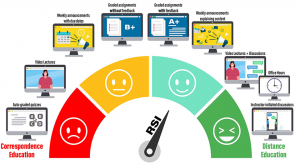Regular and Substantive Interaction
U.S. Department of Education regulations for distance (online) education mandates all distance education courses in which students may use federal financial aid must incorporate regular and substantive interaction (RSI) between students and instructors to promote student motivation and success. Institutions are required to monitor and evaluate distance education offerings to ensure there is regular and substantive interaction (RSI) between students and faculty.

Image source: OSCQR.SUNY.EDU
In online courses of any kind, (asynchronous, synchronous, blended/hybrid), regular and substantive interactions should:
- Be with an instructor as defined by the institution’s accreditor.
- Be initiated by the instructor.
- Be scheduled and predictable.
- Be academic in nature and relevant to the course.
- Be a substantive interaction, which (assumes instructor-initiated academic interaction that is scheduled and predictable, and) engages learners in teaching, learning, and assessment, consistent with the content under discussion, and also includes at least two of the following:
- Providing direct instruction (i.e., live synchronous online interactions where instructor and learners are present online at the same time);
- Assessing or providing feedback on a student’s coursework;
- Providing information or responding to questions about the content of a course or competency;
- Facilitating a group discussion regarding the content of a course or competency; or,
- Other instructional activities approved by the institution’s or program’s accrediting agency
Accessibility
In addition to the laws enforcing regular and substantive interaction, there are critical federal laws that mandate accessibility in digital learning environments. Section 504 of the Rehabilitation Act of 1973 and the Americans with Disabilities Act (ADA) of 1990, establish clear legal requirements for digital accessibility in higher education. These laws require that all campus digital resources must be fully accessible to all users. This means learners with disabilities can effectively access and utilize all digital learning materials and technologies designed for learning purposes.
UCA defines accessibility:
“Accessibility is the degree to which a product, device, program, service, resource, or environment is available to a given user. Information and communication technology is considered accessible if it can be used as effectively by people with disabilities as it can by those without disabilities. Comparable access to information must be provided, taking the needs of all users and learners into account. True accessibility provides for not just the sightless and the hearing impaired but also the color blind, those prone to seizures, and people with physical limitations that require keyboard navigation rather than the use of a mouse. It is essential that the web and content are accessible in order to provide equal access and equal opportunity to people with disabilities.”
Compliance is not optional; it is a legal and ethical imperative to create inclusive learning environments that provide equal access to educational opportunities for all individuals, regardless of disability status.
Ensuring Compliance at UCA
All synchronous online courses at the University of Central Arkansas are required to the meet federal regulations for RSI and accessibilty. The table below provides the criteria used to measure and evaluate compliance within online courses, using standards from the Online Course Quality Review Rubric (OSCQR). It is important to keep in mind that while the main purpose of the RSI regulation is to differentiate between distance and correspondence courses for financial aid purposes, the result of such efforts contributes to a better learning experience for all students.
Federal Distance Education Requirement
Link
1. Regular and substantive interaction between instructor and learner is provided throughout the course and is primarily instructor-initiated. (OSCQR #2, #3, #29, #38, #39, #41, #43)
Here’s a helpful table providing common examples of what is (and is not) considered RSI according to the federal definitions.
Americans with Disabilities Act
Link
2. All text, including PDFs and images containing text, is readable by assistive technology. (OSCQR #34)
3. Accessible descriptions (formerly Alt text) convey the meaning of (not merely describing) the images, charts, graphs, or diagrams. (OSCQR #35)
5. Hyperlink text is descriptive and makes sense when out of context; avoid using “click here.” (OSCQR #37)
6. Internet resources, including videos and publisher materials, meet accessibility standards. (OSCQR #15)
7. All multimedia includes narrative descriptions, transcripts, and closed captioning at 99% accuracy, where applicable. (OSCQR #35)
8. Learners are informed when a timed response is required. Proper lead time is provided to ensure there is an opportunity to prepare an accommodation. (OSCQR #48)
